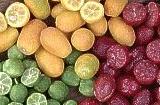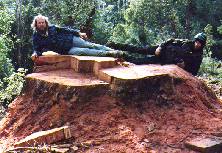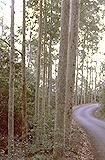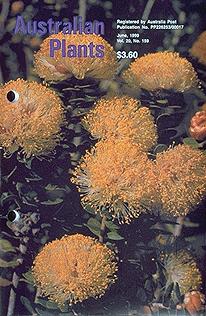|
[Front Page] [Features] [Departments] [Society Home] [Subscribe]

First Cuttings
Australian Plants Societies
Australian Plants online is brought to you by the 7 Societies that make up the Association of Societies for Growing Australian Plants (ASGAP).
Have you ever thought of joining one of the Societies? There is a Regional Society in every Australian state and also in the Australian Capital Territory. In addition, there are over 100 district groups established in centres throughout Australia.
Membership brings many benefits - regular district group and Regional newsletters, the colour journal "Australian Plants", access to free seed banks, regular meetings with expert speakers, bush walks, garden visits, advice from experienced growers, access to difficult to obtain plants and access to Study Groups.
Why not take a look at the Membership Page and see what we have to offer?

Native Citrus hits the Limelight!
CSIRO Plant Industry and Australian Native Produce Industries, a company that grows and sells Australian native food, recently announced the first commercial harvest of of fruit developed from Australian native limes.
"Australia has a range of true citrus native limes," says Dr Steve Sykes of CSIRO Plant Industry. "They include the Finger Lime (Citrus australasica), which is long and narrow like a finger and may vary from green, through pink to a dark burgundy colour when ripe; the Round Lime or 'Dooja' (Citrus australis), and the drought tolerant Desert Lime (Citrus glauca)."
Dr Sykes' original aim in investigating the native limes was to find out if their useful characteristics such as disease resistance, salt tolerance and fruit colour could be bred into conventional citrus fruits.
Each of the different native limes has its own unique taste. They are all relatively acidic like a lemon, but are excellent when used in sauces. Three varieties, each bred by Dr Sykes at Merbein in northwest Victoria, are now being evaluated in commercial orchards in Australia.
 |
Three citrus varieties bred by CSIRO.
Outback Lime (left), Sunrise Lime (centre) and Blood Lime (right).
Select the thumbnail image or highlighted name for a higher resolution image (34k). Photo: CSIRO
|
These include the Blood Lime, a cross between a mandarin and a Finger Lime and characterised by its blood red rind, flesh and juice; the Sunrise Lime, a pear shaped orange fruit that makes an excellent marmalade; and the Outback Lime, a cultivar of the Desert Lime with small green, juicy fruits which ripen at Christmas time. The advantage of these varieties is that they can be propagated onto normal citrus rootstocks to yield consistent and quite large volumes of fruit.
Andrew Beal of Australian Native Produce Industries (ANPI) was one of the first people to recognise the potential of Dr Sykes' research into native limes nearly ten years ago.
"We are always on the lookout for new and interesting Australian native foods," says Mr Beal. "Using the CSIRO Plant Industry bred varieties of native limes, we have established over 16,000 native lime trees planted throughout the citrus growing areas of Australia."
These trees will now supply ANPI's requirements for the native lime fruit in their manufactured products which are proving very popular, especially overseas. ANPI plan to treble the number of trees in their native lime orchards to keep up with anticipated demand.

Red-flowered Acacia to be Released
A few years ago rumours of the discovery of a red-flowered wattle in Victoria started to emerge (see Australian Plants online, December 1998 issue). However, little follow-up information has been forthcoming. Until now!
The February/March 2001 issue of the trade magazine Greenworld reports that the red wattle (a form of Acacia leprosa) is to be released commercially next year. Although the original plant in the bush has apparently died, the cultivar was propagated successfully at the Royal Botanic Gardens, Melbourne.
The red wattle has been chosen as Victoria's Centenary of Federation floral emblem and will be known as "Scarlet Blaze".
Acacia leprosa grows anything from 3 to 10 metres high. It will be interesting to see what claims are made for the growth habit of the cultivar. However, there are no doubts about the flower colour - it is a deep crimson. you can view excellent photographs of the flowers on the Australian National Botanic Gardens' website.

Centenary of Federation - Floral Emblems
To celebrate Australia's Centenary of Federation, each State and Territory has selected a floral emblem. The red-flowered Acacia mentioned above is Victoria's emblem. The full list is shown below.
It's disappointing to note that the two Territories were apparently unable to find an Australian plant to celebrate this important Australian event.
Centenary of Federation - Floral Emblems
| State or Territory | Floral Emblem |
| Australian Capital Territory | Rosa "Canberra Rose" |
| New South Wales | Actinotus helianthi - Flannel Flower |
| Northern Territory | Alpinia purpurata hybrid (Pink ginger) |
| Queensland | Bracteantha bracteata hybrids |
| South Australia | Thryptomene ericaea - Heath myrtle |
| Tasmania | Phebalium daviesii - Wax flower |
| Victoria | Acacia leprosa "Scarlet Blaze" |
| Western Australia | Anigozanthos rufus - Red kangaroo paw |
For more information about events concerning the Centenary of Federation, visit the Centenary of Federation website.

Register of Significant Stumps
This idea is a new twist on the "Register of Signicant Trees" that a number of Parks Authorities, local Councils and others have introduced.
The Register of Significant Stumps is an initiative of the Western Australian Forest Alliance and is a "shame file" which documents the destruction of signicant trees to illustrate what has been lost.
The idea has lots of potential to be adopted elsewhere.
The following is an extract from the Register.
| REGISTER OF SIGNIFICANT STUMPS |
 |
| TYPE OF TREE |
KARRI |
| WHERE IS IT |
SWARBRICK FOREST |
| WHEN WAS IT DESTROYED |
LATE 90's |
| WHO DESTROYED IT |
CALM |
CIRCUMFERENCE
(breast height) |
. |
DIAMETER
(breast height) |
. |
APPROX. AGE
(WHEN FELLED) |
. |
| COMMENT |
. |
|

Trees to Combat Salinity
Scientists at the CSIRO believe that planting trees, especially spotted gum, in ancient river beds could combat rising groundwater and salinity in the rice fields of the Murray Irrigation Area. It is believed that suitable land, such as sandy or loam soils in areas with low-salinity groundwater at a depth of 2-3 metres, can be found for tree plantations. In past eras, large streams crossed the region, and the extensive sandy areas are relics of these ancient river beds.
 |
Plantations of spotted gum Corymbia maculata may halt rising saline water tables in rice-growing areas.
Select the thumbnail image or highlighted name for a higher resolution image (45k).
|
Currently about 10% (55,000 ha) of the region's land area is under rice and another 40% is under pasture or other crops. Scientists estimate that a total of about 11,000 ha of carefully placed, well-managed spotted gum plantation may help to stop rising water tables in the area.
If trees are planted in sandy or loam soil that allows deep root penetration, they should begin tapping the groundwater within 2 or 3 years of planting. From then on irrigation may be unnecessary, except perhaps an occasional application to flush salt from soil in the trees' root zone.
The best plantation uptake figure for flooded gum (Eucalyptus grandis), a species widely used for farm forestry, was around 300 mm of groundwater a year. Spotted gum (Corymbia maculata) did much better, taking up to 600 mm of groundwater per year. Spotted gum apparently has a lot of roots in the capillary fringe just above the water table.
CSIRO Media Release Thursday, 4 January 2001
|








